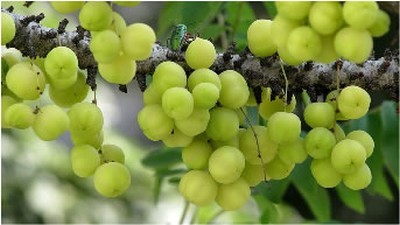
Common Name: Amla, Amalki
English Name: Emblic Myrobalan; Indian gooseberry.
Botanical Name: Emblica officinalis Gaertn, Phyllanthus emblica Linn.
Family: Euphorbiaceae
Description: It grows in warmer and tropical parts of India. Its feathery leaves, which smell like lemon, are of linear oblong shape and size 10 to 12 mm in length and 3 to 6 mm in width. The flowers of this herb are monoecious, having greenish-yellow color. They grow in auxiliary clusters and start appearing at the beginning of spring season. The fruit is almost spherical in shape, light-greenish yellow in color and appears to be very hard. Its taste is sour and bitter.
Chemical Properties: The fruits of Emblica officinalis are rich in tannins. The fruits have 28% of the total tannins distributed in the whole plant. The fruit contains two hydrolysable tannins Emblicanin A and B, which have antioxidant properties, one on hydrolysis gives gallic acid, ellagic acid and glucose wherein the other gives ellagic acid and glucose.The fruit also contains Phyllemblin. The fruits, leaves and bark are rich in tannins. The root contains ellagic acid and lupeol and bark contains leucodelphinidin. The seeds yield a fixed oil (16%) which is brownish-yellow in colour. It has the following fatty acids: linolenic (8.8%), linoleic (44.0%), oleic (28.4%), stearic (2.15%), palmitic (3.0%) and myristic (1.0%).
Properties: Various parts of the plant are used to treat a range of diseases, but the most important is the fruit. The fruit is used either alone or in combination with other plants to treat many ailments such as common cold and fever; as a diuretic, laxative, liver tonic, anti-inflammatory, hair tonic; as a digestive. Preclinical studies have shown that amla possesses antitussive, adaptogenic, cardioprotective, gastroprotective, antihypercholesterolemia, wound healing, antidiarrheal, hepatoprotective properties. Amla is also reported to possess radiomodulatory, chemomodulatory, chemopreventive effects, free radical scavenging, antioxidant, anti-inflammatory, antimutagenic and immunomodulatory activities, properties that are efficacious in the treatment and prevention of cancer
Used in the following MATXIN products: